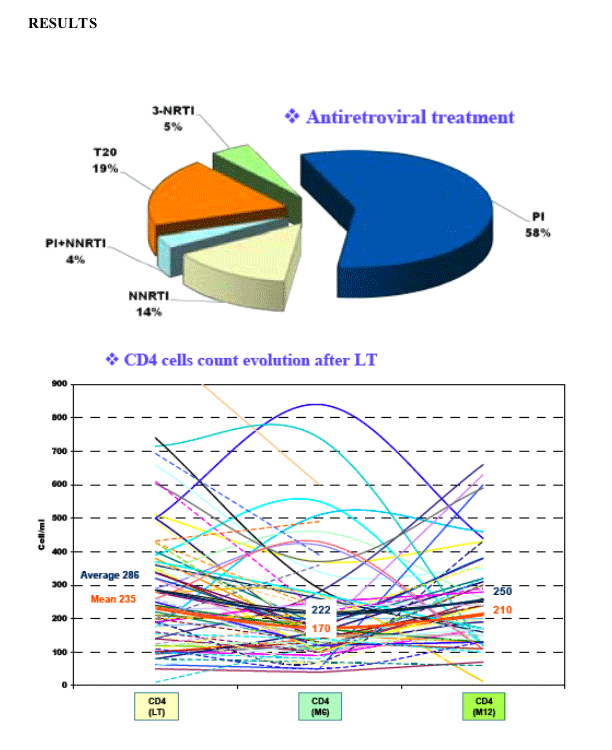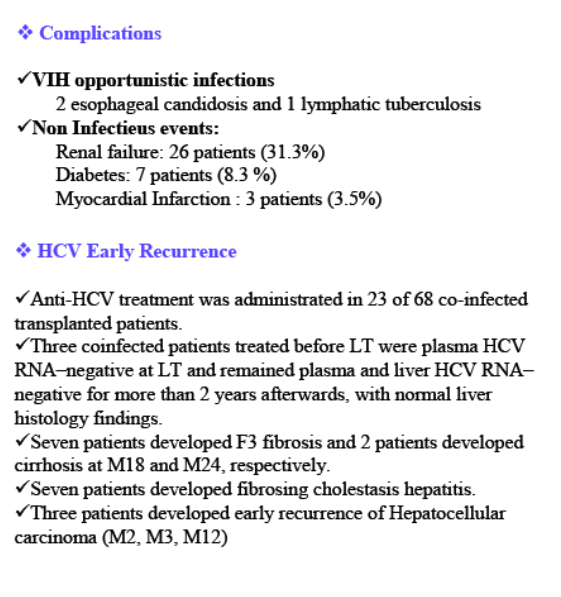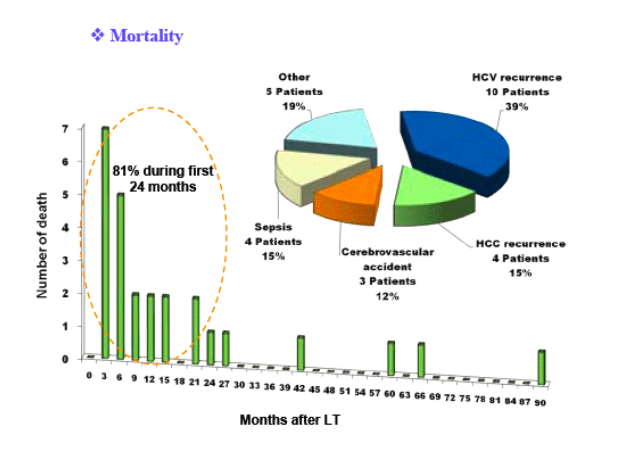 |
 |
 |
| |
Liver Transplantation in 88 HIV-infected Patients
|
| |
| |
Reported by Jules Levin CROI 2009 Montreal Feb 8-12-Elina Teicher*, J-C Duclos Vallee, D Samuel, D Castaing, A Roque Afonso, M Sebagh, C Abbara, A Taburet, and D Vittecoq
Paul Brousse Hospital, Villejuif, France
"LT performed in HIV-infected patients with controlled HIV infection is feasible providing strict selection criteria are respected in well disciplined patients with multi- disciplinary care management. No deleterious impact on CD4 T-cell counts was observed; immunosuppressive therapy does not alter the immune responses against opportunistic infections.
However the severe recurrence of HCV infection after LT remains a major issue in HIV-HCV infected patients."
Background: ART has improved life expectancy in HIV-infected patients, thus liver transplantation has become a reasonable treatment option in patients with end stage liver disease. Our objective was to describe clinical, biological, and immunovirological aspects in a cohort of 88 consecutive HIV/hepatitis C virus (HCV)- or hepatitis B virus (HBV)-co-infected patients who received a liver graft in our center between December 1999 and September 2008
Methods: All patients had a controlled HIV infection with a CD4 count >100 cells/mm3, no previous opportunistic infections, and an undetectable HIV plasma viral load under ART upon waiting list enrolment. Primary immunosuppressive therapy included tacrolimus or cyclosporine, mycophenolate, mofetil, and prednisone. All patients received opportunistic infection prophylaxis.
Results: The cohort included 71 men and 17 women, average age 44 years (29 to 63). The indication of liver transplantation was fulminant hepatitis (n = 2), regenerative nodular hyperplasia (n = 3), hemochromatosis (n = 1), HBV cirrhosis (n = 14), and HCV cirrhosis (n = 68). ART after liver transplantation consisted of 2 NRTI associated at: 58% PI/r, 18% enfuvirtide, 15% NNRTI, 4% PI + NNRTI and 5% received 3 NRTI. In 3 patients, HIV load increased. ART regimen was adapted to the genotype. CD4 level pre- and post-transplant were: 287±202 cells/mm3 (pre-liver transplantation), at 6 months 217±163 cells/mm3, at 12 months 257±145 cells/mm3. Survival at 2 years was 78% and 73% at 5 years. We diagnosed 5 opportunistic infections: 2 esophageal candidiasis, 2 primary cytomegalovirus (CMV) infections, and 1 lymphatic tuberculosis. Of the 88 patients, 25 (28%) died from a severe recurrence of HCV infection (n = 10), a recurrence of hepatocellular carcinoma (n = 4), pancreatic carcinoma (n = 1), cardiac arrest (n = 2), cerebral hemorrhage (n = 2), sepsis (n = 4), and digestive hemorrhage (n = 2). Anti-HCV treatment was administrated in 23 of 68 co-infected transplanted patients due to severe hepatitis or accelerated fibrosis. Renal failure was noted in 26 patients (31.3%) and diabetes in 6 patients (7.3 %).
Conclusions: liver transplantation performed in HIV-infected patients with controlled HIV infection is feasible providing strict selection criteria are respected in well-disciplined patients with multi-disciplinary care management. No deleterious effect on CD4 T cell counts was observed; immunosuppressive therapy does not alter the immune responses against opportunistic infections. However, the severe recurrence of HCV infection after liver transplantation remains a major issue in HIV/HCV-co-infected patients.
The advent of highly active antiretroviral therapy (HAART) has dramatically modified the prognosis of HIV-infected patients. HIV infection is now managed as a chronic disease and is no longer a contraindication for liver transplantation (LT), provided that HIV replication is under control. LT has become a reasonable treatment option in HIV-infected patients with end stage liver disease. The objective of this trial is to describe clinical, biological and immunovirological aspects in a cohort of 88 consecutive HIV/HCV or HBV co-infected patients who received a liver graft in our centre between December 1999 and September 2008
METHODS
Population: all liver recipients HIV infected patients had a controlled HIV infection with a CD4 count >100 cells/mm3, no previous opportunistic infections and an undetectable HIV plasma viral load under antiretroviral therapy upon waiting list enrolment.
Since 1999, the cohort included: 71 men and 17 women, average age = 44 years [range: 29-63]-The indication of liver transplantation was:
fulminant hepatitis (n=2)
regenerative nodular hyperplasia (n=3)
hemochromatosis (n=1)
HBV cirrhosis (n=14)
HCV cirrhosis (n=68).
-Immunosuppressive therapy included tacrolimus or cyclosporine, mycophenolate, mofetil and prednisone.
-Primary prophylaxis: all patients received 600 mg cotrimoxazole and gancyclovir 10mg/kg/day.-Antiretroviral treatment was discontinued during transplant surgery and the immediate postoperative period, in order to ensure that immunosuppressant concentrations remained predictable. Antiretroviral treatment was reintroduced 14 days after liver transplantation, the time necessary to normalize liver function parameters and to achieve stable immunosuppressant levels in the blood.



|
| |
|
 |
 |
|
|